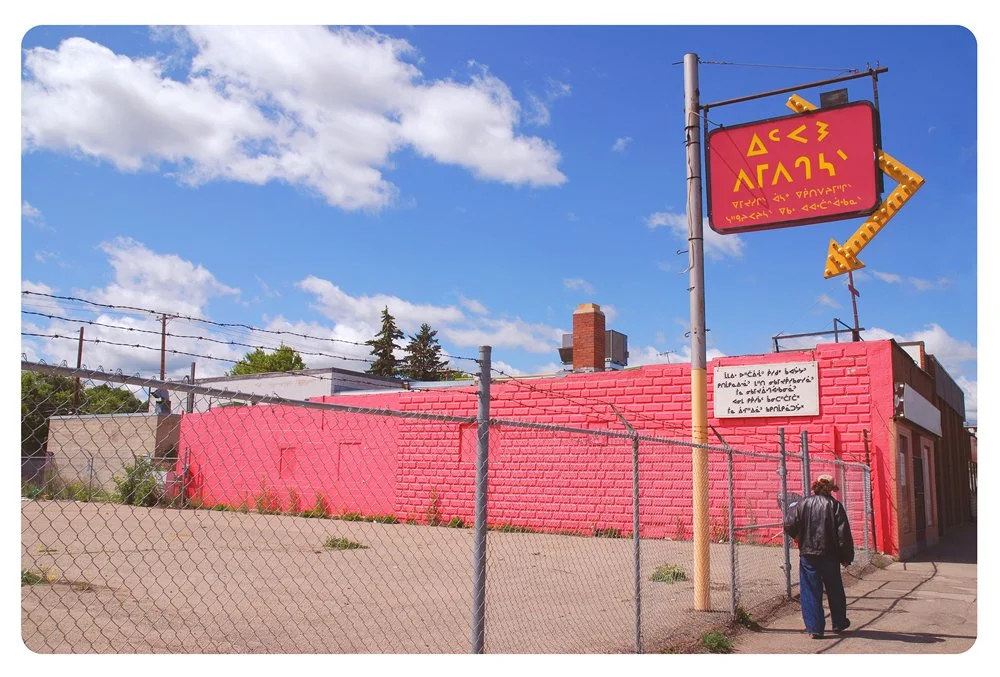Joi T. Arcand feature in Canadian Art
Canadian Art
The Optics of the Language: How Joi T. Arcand Looks with Words
When Joi T. Arcand remakes signage with Cree syllabics, she loops us into new modes of perception, straddling the threshold of radical hope
Joi T. Arcand, Town Hall, 2009. From the Here on Future Earth series. Courtesy the artist.
by Billy-Ray Belcourt (exerpts of article reposted from Canadian Art website)
Joi T. Arcand is a photo-based artist and industrial sculptor from Muskeg Lake Cree Nation, and she knows that words, that letter forms, shapes and glyphs, “change the visual landscape,” that they are how we go about practicing new ways of looking. Words are emotional architectures, and Arcand calls hers “Future Earth.”
Joi T. Arcand, Amber Motors, 2009. From the Here on Future Earth series. Courtesy the artist.
Here on Future Earth is a series of photographs that Arcand produced in 2010. In a phone interview, Arcand explained to me that this is where her photo-based practice and her interest in textuality synched. Arcand wants us to think about these photographs as documents of “an alternative present,” of a future that is within arm’s reach.
For this series, Arcand manipulated signs and replaced their slogans and names with Cree syllabics. By doing this, Arcand images something of a present beside itself and therefore loops us into a new mode of perception, one that enables us to attune to the rogue possibilities bubbling up in the thick ordinariness of everyday life. Arcand wanted to see things “where they weren’t.”
Hers is not a utopian elsewhere we need to map out via an ethos of discovery. Rather, Arcand straddles the threshold of radical hope. She asks us to orient ourselves to the world as if we were out to document or to think back on a future past. That is, Arcand rendered these photographs with a pink hue and a thick, round border, tapping into what she calls “the signifiers of nostalgia.” Importantly, these signifiers are inextricably bound to the charisma of words, to the emotional life of the syllabics. The syllabics are what enunciate; they potentiate a performance of world-making that does not belong to the mise-en-scene of settlement.
Joi T. Arcand, Sweetgrass Store, 2009. From the Here on Future Earth series. Courtesy the artist.
The modified signs exploit our ability to look; that we see them and conceptualize them as out of place or untimely is how we transport ourselves to a different time, to a place governed by Indian time. The syllabics themselves map a visual field. This is what Arcand calls “the optics of the language.”
In one sign, Arcand translates the English phrase “I don’t have the words” into Cree. “I don’t have the words” is a paradoxical speech act; it uses words to announce their absence.
These signs interrupt the visual terrain of the gallery, as if welcoming onlookers to a new world, to a new geographic form. The signs something like kinship around a common wordlessness in the service of a new world-making praxis.
These photographs and signs, then, are all relics of a future past. They emerge from something of an anthropological interest in a future-in-the-present, in the affects of Indian time. Arcand thus writes the world wrong so that she can write it anew.
Billy-Ray Belcourt is from the Driftpile Cree Nation. He is a PhD student in the Department of English and Film Studies at the University of Alberta.


